History
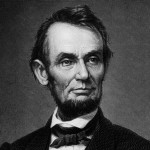 In the early years of politics in the United States, the political parties had different names than they do these days. Of course, with the additional parties we have now, it is an ever changing political scene, with the lesser parties visible, but unlikely to win the office of President of the United States…at least for now. The First Party System of the United States featured the Federalist Party and the Democratic-Republican Party (also called “Democratic-Republican” or “Jeffersonian Republican”), these were in place from 1792 to 1824. The Whig Party, led by Henry Clay, that grew from the National Republican Party, and the Democratic Party, led by Andrew Jackson, were in play from 1828 to 1854. The Third Party System stretched from 1854 to the mid-1890s, and was characterized by the emergence of the anti-slavery Republican Party (nicknamed “GOP”), which adopted many of the economic policies of the Whigs, such as national banks, railroads, high tariffs, homesteads and aid to land grant colleges. It was into this time-frame that President Abraham Lincoln entered office.
In the early years of politics in the United States, the political parties had different names than they do these days. Of course, with the additional parties we have now, it is an ever changing political scene, with the lesser parties visible, but unlikely to win the office of President of the United States…at least for now. The First Party System of the United States featured the Federalist Party and the Democratic-Republican Party (also called “Democratic-Republican” or “Jeffersonian Republican”), these were in place from 1792 to 1824. The Whig Party, led by Henry Clay, that grew from the National Republican Party, and the Democratic Party, led by Andrew Jackson, were in play from 1828 to 1854. The Third Party System stretched from 1854 to the mid-1890s, and was characterized by the emergence of the anti-slavery Republican Party (nicknamed “GOP”), which adopted many of the economic policies of the Whigs, such as national banks, railroads, high tariffs, homesteads and aid to land grant colleges. It was into this time-frame that President Abraham Lincoln entered office.
Abraham Lincoln was elected the 16th president of the United States over a deeply divided Democratic Party, becoming the first Republican to win the presidency. Lincoln received only 40 percent of the popular vote but handily defeated the three other candidates…Southern Democrat John Breckinridge, Constitutional Union candidate John Bell, and Northern Democrat Stephen Douglas, a United States senator from Illinois. Lincoln, a Kentucky-born lawyer and former Whig representative to Congress, first gained national stature during his 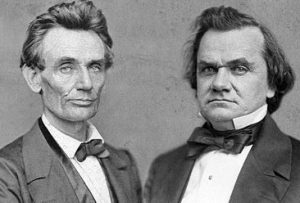 campaign against Stephen Douglas of Illinois for a United States Senate seat in 1858. The senatorial campaign featured a remarkable series of public encounters on the slavery issue, known as the Lincoln-Douglas debates, in which Lincoln argued against the spread of slavery, while Douglas maintained that each territory should have the right to decide whether it would become free or slave. Lincoln lost the Senate race, but his campaign brought national attention to the young Republican Party. In 1860, Lincoln won the party’s presidential nomination.
campaign against Stephen Douglas of Illinois for a United States Senate seat in 1858. The senatorial campaign featured a remarkable series of public encounters on the slavery issue, known as the Lincoln-Douglas debates, in which Lincoln argued against the spread of slavery, while Douglas maintained that each territory should have the right to decide whether it would become free or slave. Lincoln lost the Senate race, but his campaign brought national attention to the young Republican Party. In 1860, Lincoln won the party’s presidential nomination.
I find it very odd that today’s Democrats try to take credit for racial equality, when history proves that the opposite was true. When we look at the wars and the votes by the party numbers, it is easy to see that the Democratic party has long been the one trying to keep racial injustice going in this country. In fact, it was Lincoln’s anti-slavery views that caused the secession of seven southern states in protest, because they wanted to keep their slaves. Now, many people are wanting to tear down the statues that were erected to the heroes of the south…all Democrats, and it is the Democratic Party that is leading the fight. In my opinion, it is like tearing yourself apart from the inside. The Democratic Party, in an effort to appear to be the ones trying to obtain equal rights for all races, is, on the outside anyway trying to appear to agree, while on the inside, they are just trying to take eyes off of their own underhanded agenda. I don’t know how I feel about the removal of those statues, but I don’t like that the Republicans and Conservatives are being blamed for the initial placement of the statues.
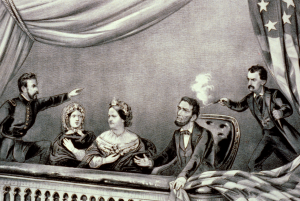
In 1863, as the tide turned against the Confederacy, Lincoln emancipated the slaves and in 1864 won reelection. In April 1865, he was assassinated by Confederate sympathizer John Wilkes Booth at Ford’s Theatre in Washington DC. The attack came only five days after the American Civil War effectively ended with the surrender of Confederate General Robert E. Lee at Appomattox. For preserving the Union and bringing an end to slavery, and for his unique character and powerful oratory, Lincoln is hailed as one of the greatest American presidents. And amazingly…at least to the Democrats, he was a Republican.
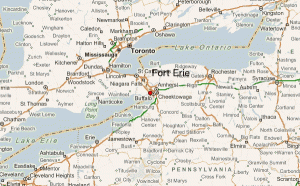
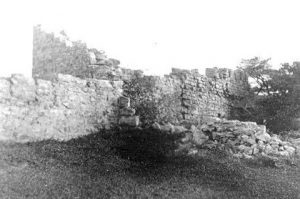 Part of the War of 1812 involved a border dispute between the United States and British North America, which is present-day Canada. During the war, the Americans launched several invasions into Upper Canada, at the point of present-day Ontario. One section of the border where this was easiest, because of communications and locally available supplies, was along the Niagara River. Fort Erie was the British post at the head of the river, near its source in Lake Erie. In 1812, two American attempts to capture Fort Erie were bungled by Brigadier General Alexander Smyth. Bad weather or poor administration halted the American efforts to cross the river, and Fort Erie remained in British hands.
Part of the War of 1812 involved a border dispute between the United States and British North America, which is present-day Canada. During the war, the Americans launched several invasions into Upper Canada, at the point of present-day Ontario. One section of the border where this was easiest, because of communications and locally available supplies, was along the Niagara River. Fort Erie was the British post at the head of the river, near its source in Lake Erie. In 1812, two American attempts to capture Fort Erie were bungled by Brigadier General Alexander Smyth. Bad weather or poor administration halted the American efforts to cross the river, and Fort Erie remained in British hands.
In 1813, the Americans won the Battle of Fort George at the northern end of the Niagara River. At this point, the British abandoned the Niagara frontier and allowed Fort Erie to fall into American hands without a fight. Unfortunately, the Americans failed to follow up their victory, and later in the year they withdrew most of their soldiers from the Niagara to furnish an ill-fated attack on Montreal. This allowed the British to recover their prior positions and to mount raids which led to the Capture of Fort Niagara and the devastation of large parts of the American side of the Niagara River.
For 1814, a new invasion of Upper Canada was planned under the command of Major General Jacob Brown. Originally aimed at Kingston on Lake Ontario, it was switched to the Niagara because British ships controlled Lake Ontario for the first six months of 1814. The United States finally captured Fort Erie in 1814. It was thought that the British, while outnumbered, surrendered Fort Erie prematurely…at least in the view of the British commanders. They fully expected the outnumbered British troops to stand and fight…to the death, if need be. Because American troops were already concentrated at Buffalo and Black Rock, the attack was to be launched across the southern part of the Niagara frontier. Fort Erie was the first objective that stood in the way, and so, its capture was required. Lieutenant General Gordon Drummond, the British commander in Upper Canada, hoped that the garrison at Fort Erie could at least buy him enough time against the American invasion to concentrate his forces. Major Thomas Buck was given command of the fort with a garrison of 137 British soldiers.
Brown’s force crossed into Canada on July 3, 1814. Brigadier General Winfield Scott landed a mile and a half north of the fort with a brigade of regulars while it was still dark. Another brigade under Eleazar Wheelock Ripley crossed the head of the river to the south of the fort, a little behind schedule due to fog. Meanwhile, New York militia demonstrated opposite Chippewa to distract the British troops in the area. As Scott’s and Ripley’s forces approached Fort Erie, Buck fired only a few shots at the Americans from the fort’s cannon and then surrendered. The Americans had captured an important fort at little cost. The fort’s garrison had bought the British very little time and Buck was later court martialed for his hasty surrender.
From their new base at Fort Erie, Brown next marched up the Niagara River and met the British at the Battle of Chippewa. The British commander at Chippewa, Major General Phineas Riall, believed that the garrison of Fort Erie was still holding out, which contributed to his decision to launch a hasty and ill-fated attack. Following the Battle of Lundy’s Lane in July, British forces under the command of Gordon Drummond advanced and unsuccessfully attempted to besiege the fort. After that it remained in American hands until the American commanders decided to abandon the fort, which was evacuated and blown up in November 1814. These days, with so many historic forts across the nation, it was shocking to me to read that they had blown up the fort, 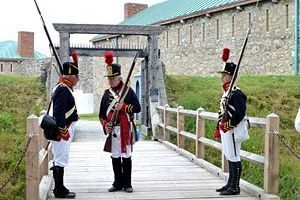
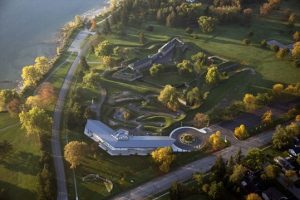 but I guess they weren’t interested in the historic side of things…they were making history. The fort, which had been built by the British in 1764, was restored, and was incorporated as a village in 1857. It became a town when it merged with Bridgeburg in 1932. Fort Erie is now the site of a large horse-racing track and has steel, aircraft, automotive, paint, and pharmaceutical industries. It is a town with a population of 29,960 in 2011.
but I guess they weren’t interested in the historic side of things…they were making history. The fort, which had been built by the British in 1764, was restored, and was incorporated as a village in 1857. It became a town when it merged with Bridgeburg in 1932. Fort Erie is now the site of a large horse-racing track and has steel, aircraft, automotive, paint, and pharmaceutical industries. It is a town with a population of 29,960 in 2011.
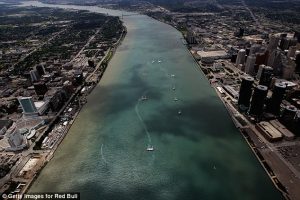 When a body of water stands between two places that people need to go, there are a few options to solve the dilemma…a bridge, a road around, or as was the case of a way across the Detroit River, a tunnel. With a river, you can’t really go around, so often it’s a bridge, but in this case there was a great deal of opposition to a bridge over the river. Since the beginning of the 19th century, Detroiters and Windsorians had been trying to find a way to move people and goods back and forth across the Detroit River. For decades, railroad interests proposed tunnels and bridges galore, but powerful advocates of marine shipping always managed to block those projects, because they did not want to lose business to faster and more capacious trains. Plans for bridges were particularly troubling to those shippers, since just one low-hanging bridge had the potential to keep high-masted sailing vessels off the river altogether.
When a body of water stands between two places that people need to go, there are a few options to solve the dilemma…a bridge, a road around, or as was the case of a way across the Detroit River, a tunnel. With a river, you can’t really go around, so often it’s a bridge, but in this case there was a great deal of opposition to a bridge over the river. Since the beginning of the 19th century, Detroiters and Windsorians had been trying to find a way to move people and goods back and forth across the Detroit River. For decades, railroad interests proposed tunnels and bridges galore, but powerful advocates of marine shipping always managed to block those projects, because they did not want to lose business to faster and more capacious trains. Plans for bridges were particularly troubling to those shippers, since just one low-hanging bridge had the potential to keep high-masted sailing vessels off the river altogether.
In 1871, the region’s railroads finally won permission to build a trans-national tunnel, and workers began to dig into the river at the foot of Detroit’s San Antoine Street. They were forced to abandon the project just 135 feet  under the river, however, when they struck a pocket of sulfurous gas that made workers so ill that none could be persuaded to return. Likewise, in 1879, another tunnel had to be abandoned when it ran right into some unexpectedly difficult to excavate limestone under the river. The first successful Michigan to Canada tunnel project finally opened in 1891. It was the 6,000 foot long Grand Trunk Railway Tunnel at Port Huron.
under the river, however, when they struck a pocket of sulfurous gas that made workers so ill that none could be persuaded to return. Likewise, in 1879, another tunnel had to be abandoned when it ran right into some unexpectedly difficult to excavate limestone under the river. The first successful Michigan to Canada tunnel project finally opened in 1891. It was the 6,000 foot long Grand Trunk Railway Tunnel at Port Huron.
Soon enough, it was clear to most people on both sides of the border that they needed to build some sort of structure for transporting automobiles across the river too. In June 1919, the mayors of Detroit and Windsor decided to build a city to city tunnel that would serve as a memorial to the American and Canadian soldiers who had died in World War I. Even after advocates of the under-construction Ambassador Bridge tried to frighten away the tunnel’s backers by spreading rumors about the danger of subterranean carbon monoxide poisoning, the tunnel boosters were undeterred. One said, they were “inspired by God to have this tunnel built.” Construction began in 1928. First, barges were used to dredge a 2,454 foot long trench across the river. Then workers sank nine 8,000 ton steel and concrete tubes into the trench and welded them together. Finally, an  elaborate ventilation system was built to make sure that the air in the tunnel safe to breathe.
elaborate ventilation system was built to make sure that the air in the tunnel safe to breathe.
On Nov 1, 1930, President Herbert Hoover turned a telegraphic Golden Key in the White House to mark the opening of the 5,160 foot long Detroit-Windsor Tunnel between the United States city of Detroit, Michigan, and the Canadian city of Windsor, Ontario. The tunnel opened to regular traffic on November 3, 1930. The first passenger car it carried was a 1929 Studebaker. In the first nine weeks it was open, nearly 200,000 cars passed through the Detroit-Windsor Tunnel. Today, about 9 million vehicles use the tunnel each year.
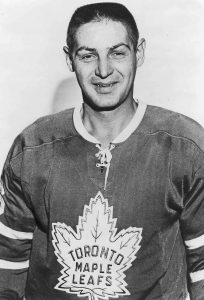
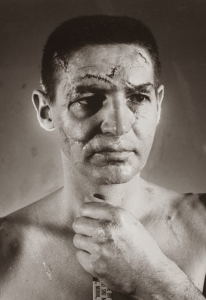 If you could see all of Terry Sawchuk’s wounds at once, his face would look like this one that was reproduced with makeup. In reality, Terry’s wounds have healed over the years, and the scars are not nearly as visible as the makeup reproduction portrays. Nevertheless, Sawchuk’s 16 years of playing goalie for the Toronto Maple Leafs hockey team in the years before the goalies wore safety equipment left their marks and took their toll on his body. Re-created here, by a professional make-up artist and a doctor, are some of the more than 400 stitches he had earned during 16 years in the National Hockey League. Terry Sawchuk’s face was bashed over and over, but not all at one time. The re-creation of his injuries was done to help show the extent of his injuries over a span of years. Sawchuk had sustained other injuries that were not shown here too…a slashed eyeball requiring three stitches, a 70% loss of function in his right arm because 60 bone chips were removed from his elbow, and a permanent “sway-back” that was caused by a continual bent-over posture during the games.
If you could see all of Terry Sawchuk’s wounds at once, his face would look like this one that was reproduced with makeup. In reality, Terry’s wounds have healed over the years, and the scars are not nearly as visible as the makeup reproduction portrays. Nevertheless, Sawchuk’s 16 years of playing goalie for the Toronto Maple Leafs hockey team in the years before the goalies wore safety equipment left their marks and took their toll on his body. Re-created here, by a professional make-up artist and a doctor, are some of the more than 400 stitches he had earned during 16 years in the National Hockey League. Terry Sawchuk’s face was bashed over and over, but not all at one time. The re-creation of his injuries was done to help show the extent of his injuries over a span of years. Sawchuk had sustained other injuries that were not shown here too…a slashed eyeball requiring three stitches, a 70% loss of function in his right arm because 60 bone chips were removed from his elbow, and a permanent “sway-back” that was caused by a continual bent-over posture during the games.
Many people were hurt playing sports in the years before safety equipment was used. For some of them, like Sawchuk, the equipment would not come in time to spare them from years of pain, and even disabilities. It was  a sad reality of many sports that everyone loves. The first goalie’s mask was a metal fencing mask donned in February 1927 by Queen’s University netminder Elizabeth Graham, mainly to protect her teeth. In 1930, the first crude leather model of the mask, which was actually an American football “nose-guard” was worn by Clint Benedict to protect his broken nose. After recovering from the injury, he abandoned the mask, never wearing one again in his career. At the 1936 Winter Olympics, Teiji Honma wore a crude mask, similar to the one worn by baseball catchers. The mask was made of leather, and had a wire cage which protected the face, as well as Honma’s large circular glasses.
a sad reality of many sports that everyone loves. The first goalie’s mask was a metal fencing mask donned in February 1927 by Queen’s University netminder Elizabeth Graham, mainly to protect her teeth. In 1930, the first crude leather model of the mask, which was actually an American football “nose-guard” was worn by Clint Benedict to protect his broken nose. After recovering from the injury, he abandoned the mask, never wearing one again in his career. At the 1936 Winter Olympics, Teiji Honma wore a crude mask, similar to the one worn by baseball catchers. The mask was made of leather, and had a wire cage which protected the face, as well as Honma’s large circular glasses.
Finally, in 1959 goalies began wearing masks full-time. On November 1, 1959, in a game between the Montreal Canadiens and New York Rangers of the National Hockey League, Canadiens goaltender Jacques Plante was struck in the face by a shot from Andy Bathgate. He had previously worn a face mask in practice, but coach Toe Blake refused to allow him to wear it in a game. He thought it might inhibit his vision. After being stitched up, Plante gave Blake an ultimatum. He refused to go back out onto the ice without the mask. Blake agreed, not wanting to forfeit the game, because NHL teams did not have back-up goalies at the time. Plante went on a long unbeaten streak wearing the mask. That ended when he was asked to remove it for a game. After that particular loss, Plante resumed donning the mask for the remainder of his career. Plante was ridiculed when he introduced the mask into the game. People questioned his dedication and bravery. In response, Plante made an analogy to a person skydiving without a parachute. Although Plante faced some 
 teasing, the face-hugging fiberglass goalie’s mask soon became the standard. Since the invention of the fiberglass hockey mask, professional goalies no longer play without a mask. The last goalie to play without a mask was Andy Brown, who played his last NHL game in 1974. He would then go to the Indianapolis Racers of the WHA and play without a mask till his retirement in 1977. So much has been learned about playing without protective gear since those days, but for the people who played before all that information, it came at a heavy price.
teasing, the face-hugging fiberglass goalie’s mask soon became the standard. Since the invention of the fiberglass hockey mask, professional goalies no longer play without a mask. The last goalie to play without a mask was Andy Brown, who played his last NHL game in 1974. He would then go to the Indianapolis Racers of the WHA and play without a mask till his retirement in 1977. So much has been learned about playing without protective gear since those days, but for the people who played before all that information, it came at a heavy price.
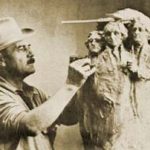
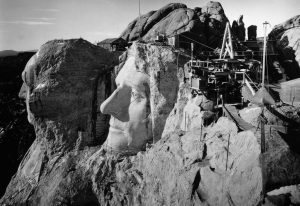 When a construction project begins, it usually takes a matter of a few months to complete. That is not how it works when carving a large sculpture, such as Mount Rushmore. Mount Rushmore National Memorial is a sculpture carved into the granite face of Mount Rushmore, a batholith in the Black Hills in Keystone, South Dakota, United States. It was the vision of Doane Robinson, who thought that carving the faces of famous people in the Granite of the Black Hills region, would bring tourists to the region. Robinson’s vision has proven to be an amazing success. His original idea was to put the sculpture in the area of the Needles, but the chosen sculptor, Gutzon Borglum rejected the idea because of the poor quality of the granite, and strong opposition from the Native American Groups in the area. I’m glad it didn’t go in the needles area, because they have a beauty all their own, and it would have been a shame to change them.
When a construction project begins, it usually takes a matter of a few months to complete. That is not how it works when carving a large sculpture, such as Mount Rushmore. Mount Rushmore National Memorial is a sculpture carved into the granite face of Mount Rushmore, a batholith in the Black Hills in Keystone, South Dakota, United States. It was the vision of Doane Robinson, who thought that carving the faces of famous people in the Granite of the Black Hills region, would bring tourists to the region. Robinson’s vision has proven to be an amazing success. His original idea was to put the sculpture in the area of the Needles, but the chosen sculptor, Gutzon Borglum rejected the idea because of the poor quality of the granite, and strong opposition from the Native American Groups in the area. I’m glad it didn’t go in the needles area, because they have a beauty all their own, and it would have been a shame to change them.
They settled on Mount Rushmore, which also has the advantage of facing southeast for maximum sun exposure, which makes the faces of our presidents stand out in an amazing way. Robinson wanted it to feature American West heroes like Lewis and Clark, Red Cloud, and Buffalo Bill Cody, but Borglum decided the sculpture should have broader appeal and chose the four presidents. Borglum created the sculpture’s design and oversaw the project’s execution from 1927 to 1941 with the help of his son, Lincoln Borglum. When I think of the years it too to complete the sculpture, I wonder if it was what was expected, or just the way it came down. Mount Rushmore features 60-foot sculptures of the heads of four United States presidents…George Washington (1732–1799), Thomas Jefferson (1743–1826), Theodore Roosevelt (1858–1919), and Abraham Lincoln (1809–1865). After securing federal funding through the enthusiastic sponsorship of “Mount Rushmore’s great political patron” US Senator Peter Norbeck, construction on the memorial began in 1927, and the presidents’ faces were completed between 1934 and 1939. Upon Gutzon Borglum’s death in March 1941, his son Lincoln Borglum took over as leader of the construction project. Each president was originally to be depicted from head to waist.
The memorial park covers 1,278.45 acres and is 5,725 feet above sea level, and while the sculpture work officially ended on October 31, 1941, due to lack of funding and the very real possibility of a United States entrance into World War II. Mount Rushmore has become an iconic symbol of the United States, and it has 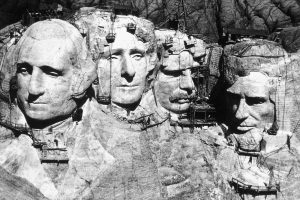
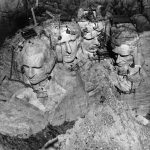 appeared in works of fiction, as well as being discussed or depicted in other popular works. It has also been featured a number of movies. It attracts over two million visitors annually. It’s amazing to me that what started out to be a tourist attraction, quickly became a must see place for every patriotic American. My husband and I love to go to the Black Hills, and with the close proximity to our Casper, Wyoming home, we take a week every summer to go and enjoy the beauty and patriotism that now resides there.
appeared in works of fiction, as well as being discussed or depicted in other popular works. It has also been featured a number of movies. It attracts over two million visitors annually. It’s amazing to me that what started out to be a tourist attraction, quickly became a must see place for every patriotic American. My husband and I love to go to the Black Hills, and with the close proximity to our Casper, Wyoming home, we take a week every summer to go and enjoy the beauty and patriotism that now resides there.
 The discovery of gold in the United States triggered massive growth, with towns springing up across the area. Helena, Montana was one of those towns. On October 30, 1864, four miners struck it rich at their appropriately named mine, “Last Chance Gulch.” From that discovery came one of the wealthiest cities in the United States by the late nineteenth century…Helena, Montana. While it was once one of the wealthiest cities, the current population of Helena doesn’t really fall in line with the direction the city appeared to be taking in 1864. As of the 2010 census the population is 28,190, making it the fifth least populous state capital in the U.S after Montpelier, Vermont; Pierre, South Dakota; Augusta, Maine; and Frankfort, Kentucky.
The discovery of gold in the United States triggered massive growth, with towns springing up across the area. Helena, Montana was one of those towns. On October 30, 1864, four miners struck it rich at their appropriately named mine, “Last Chance Gulch.” From that discovery came one of the wealthiest cities in the United States by the late nineteenth century…Helena, Montana. While it was once one of the wealthiest cities, the current population of Helena doesn’t really fall in line with the direction the city appeared to be taking in 1864. As of the 2010 census the population is 28,190, making it the fifth least populous state capital in the U.S after Montpelier, Vermont; Pierre, South Dakota; Augusta, Maine; and Frankfort, Kentucky.
My husband, Bob Schulenberg’s aunt, Marion Kanta, and her family lived in Helena until the time for her passing in 1999, and many of her family members live there still. That said, we visited the capitol city a few times, and found it to be a very nice place. Of course, during the gold rush years, things might have been very 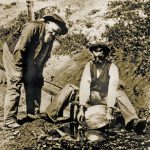 different. A gold rush town can have a tendency to be a high crime area, and when 3.6 billion dollars worth of gold is extracted in the city limits of a town over a twenty year period, you know that there were people who would like nothing more than to take over the claim of another person, no matter what it took. The first major Anglo settlement of Montana began in the summer of 1862, when prospectors found a sizeable deposit of placer gold at Grasshopper Creek to the west of what is today…Helena, Montana. When other even richer deposits were discovered nearby, a major rush began as tens of thousands of miners scoured the territory in search of gold. In 1864, four prospectors spotted signs of gold in the Helena area while on their way to the Kootenai country, but they were eager to reach the reportedly rich gold regions farther to the north and did not stop. Then, after striking out on the Kootenai, they decided to take “one last chance” on finding gold and returned. When the signs turned out to mark a rich deposit of placer gold, they staked their claims and named the new mining district Last Chance Gulch.
different. A gold rush town can have a tendency to be a high crime area, and when 3.6 billion dollars worth of gold is extracted in the city limits of a town over a twenty year period, you know that there were people who would like nothing more than to take over the claim of another person, no matter what it took. The first major Anglo settlement of Montana began in the summer of 1862, when prospectors found a sizeable deposit of placer gold at Grasshopper Creek to the west of what is today…Helena, Montana. When other even richer deposits were discovered nearby, a major rush began as tens of thousands of miners scoured the territory in search of gold. In 1864, four prospectors spotted signs of gold in the Helena area while on their way to the Kootenai country, but they were eager to reach the reportedly rich gold regions farther to the north and did not stop. Then, after striking out on the Kootenai, they decided to take “one last chance” on finding gold and returned. When the signs turned out to mark a rich deposit of placer gold, they staked their claims and named the new mining district Last Chance Gulch.
Last Chance Gulch would prove to be the second biggest placer gold deposit in Montana, producing some 19 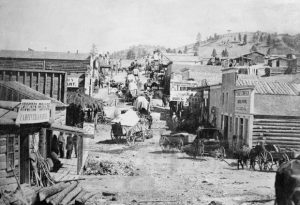 million dollars worth of gold in just four years. Almost overnight, thousands of miners flooded into the region, and the four original miners added to their fortunes by establishing the town of Helena to provide the new miners with food, lodging, and supplies. But unlike many of the early Montana mining towns, Helena did not disappear once the gold gave out, which was inevitable. Helena was able to survive and grow by serving the wider Montana mining industry, because it was located on several major transportation routes, well supplied with agricultural products from an adjacent valley, and near to several other important mining towns. In 1875, the city became the capital of Montana Territory, and in 1894, the capital of the new state of Montana.
million dollars worth of gold in just four years. Almost overnight, thousands of miners flooded into the region, and the four original miners added to their fortunes by establishing the town of Helena to provide the new miners with food, lodging, and supplies. But unlike many of the early Montana mining towns, Helena did not disappear once the gold gave out, which was inevitable. Helena was able to survive and grow by serving the wider Montana mining industry, because it was located on several major transportation routes, well supplied with agricultural products from an adjacent valley, and near to several other important mining towns. In 1875, the city became the capital of Montana Territory, and in 1894, the capital of the new state of Montana.

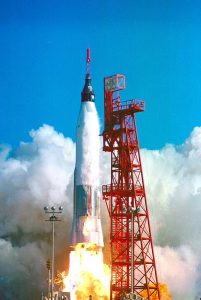 I’m sure that many of you remember the movie, Deep Impact, which was about a group of astronauts trying to save the world by deflecting a meteor, so it wouldn’t hit the earth. Robert Duvall played the part of Captain Spurgeon “Fish” Tanner, a retired, and largely considered by the rest of the crew, an “over the hill” astronaut. Nevertheless, in the end, they were glad they had him when it came to completing their mission, even though it did cost them their lives. Of course, the movie was fictional, and not realistic in many aspects, but the part that struck me as cool, was that the retired astronaut got a second chance to be useful in an important mission.
I’m sure that many of you remember the movie, Deep Impact, which was about a group of astronauts trying to save the world by deflecting a meteor, so it wouldn’t hit the earth. Robert Duvall played the part of Captain Spurgeon “Fish” Tanner, a retired, and largely considered by the rest of the crew, an “over the hill” astronaut. Nevertheless, in the end, they were glad they had him when it came to completing their mission, even though it did cost them their lives. Of course, the movie was fictional, and not realistic in many aspects, but the part that struck me as cool, was that the retired astronaut got a second chance to be useful in an important mission.
However, Captain Spurgeon Tanner wasn’t the only retired astronaut to get a second chance to go into space. On October 29, 1998, nearly four decades after he became the first American to orbit the Earth, Senator John Hershel Glenn Jr was launched into space again as a payload specialist aboard the space shuttle Discovery. At 77 years of age, Glenn was the oldest human ever to travel in space. During the nine day mission, he served as part of a NASA study on health problems associated with aging. Like our fictional Captain Spurgeon Tanner, Senator John Glenn was useful in space again. He had something that the other astronauts didn’t have…age. I don’t suppose that the studies done on John Glenn were the saving the world type, but they were real life studies, and that’s important too.
John Glenn became famous when he was chosen by NASA in 1959, along with six other men, to be the first American astronauts. He was a lieutenant colonel in the US Marine Corps. A decorated pilot, he flew nearly 150 combat missions during World War II and the Korean War. In 1957, he made the first nonstop supersonic flight across the United States, flying from Los Angeles to New York in three hours and 23 minutes. Then, in April 1961, the American space program suffered a setback of sorts, when Soviet cosmonaut Yuri Gagarin became the first man in space, and his spacecraft, Vostok 1, made a full orbit before returning to Earth. It was a feat that the United States had hoped to achieve first. The United States kicked things into high gear, and less than one month later, American Alan Shepard Jr became the first American in space when his Freedom 7 spacecraft was launched on a suborbital flight. American “Gus” Grissom made another suborbital flight in July. Then, in August, Soviet cosmonaut Gherman Titov spent more than 25 hours in space aboard Vostok 2, making 17 orbits. As a technological power, the United States looked second-rate, compared with its Cold War adversary.
If the Americans wanted to dispel this notion, they needed a multi-orbital flight before another Soviet space advance arrived. On February 20, 1962, NASA and Colonel John Glenn accomplished this feat with the flight of Friendship 7, a spacecraft that made three orbits of the Earth in five hours. Glenn was hailed as a national hero, and on February 23 President John F. Kennedy visited him at Cape Canaveral. Glenn later addressed Congress and was given a ticker-tape parade in New York City. It was at this point that NASA made the unfortunate decision not to risk the life of the now famous Glenn by sending him into space again. NASA essentially grounded the “Clean Marine” in the years after his historic flight. Frustrated with this uncharacteristic lack of activity, Glenn turned to politics, In 1964, he announced his candidacy for the US Senate from his home state of Ohio and formally left NASA. Later that year, however, he withdrew his Senate bid after seriously injuring his inner ear in a fall from a horse. In 1970, following a stint as a Royal Crown Cola executive, he ran for the Senate again but lost the Democratic nomination to Howard Metzenbaum. Four years later, he defeated Metzenbaum, won the general election, and went on to win re-election three times. In 1984, he unsuccessfully sought the Democratic nomination for president.

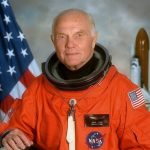
His really big claim to fame would once again come from NASA, which seemed to be his destiny after all. In 1998, Glenn attracted considerable media attention when he returned to space aboard the space shuttle Discovery. In 1999, he retired from his US Senate seat after four consecutive terms in office, a record for the state of Ohio. While his years in politics were much longer, he will always be remembered for the two historic flights he made into space.

 Growing up with the last name of Spencer, I have always been aware that I was related to the Spencers in England, including Princess Diana, her sons and grandchildren, as well as Winston Spencer Churchill. Of course, these relationships were on the Spencer side of my family, but recently, I have been stumbling upon, or in reality, tripping over royalty of the Pattan side of my family, as well as more direct ties to the English throne on the Spencer side of the family.
Growing up with the last name of Spencer, I have always been aware that I was related to the Spencers in England, including Princess Diana, her sons and grandchildren, as well as Winston Spencer Churchill. Of course, these relationships were on the Spencer side of my family, but recently, I have been stumbling upon, or in reality, tripping over royalty of the Pattan side of my family, as well as more direct ties to the English throne on the Spencer side of the family.
When I spoke to my Aunt Sandy Pattan about the king connection of the Pattan side, she said that she knew of Queen Victoria, who I had not found yet, by the way, but she was unaware of the kings in the family line, and was very surprised about where they came from…not the family background, but rather the global locations. The first one to show up was King Charles II of England, who is my 1st cousin 11 times removed. King Charles was actually the king of Scotland from January 30, 1649 to September 3, 1651, and then king of England, Scotland, and Ireland from May 29, 1660 until his death on February 6, 1685 from a stroke.
The next king to show up was King Frederick I of Prussia, who was my 2nd cousin 10 times removed. He was king from January 18, 1701 until his death on February 25, 1713 in Berlin. Next came King Louis XIV of France, who is my 3rd cousin 10 times removed. He was king from May 14, 1643 until his death on September 1, 1715 of gangrene. The next king to show up was King Frederick William II of Prussia, who is my 4th cousin 7 times removed. He was king from August 17, 1786 until his passing on November 16, 1797 in Potsdam, Germany. 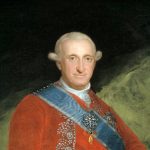

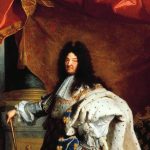 The next king was King Charles IV of Spain, who is my 4th cousin 6 times removed. He was king from December 14, 1788 to March 18, 1808. He did not end his reign upon his death, but rather, riots and popular revolt at the winter palace in Aranjuez, forced him to abdicate to his son, Ferdinand VII. He died on January 20, 1819 in Palazzo Barberini, Rome.
The next king was King Charles IV of Spain, who is my 4th cousin 6 times removed. He was king from December 14, 1788 to March 18, 1808. He did not end his reign upon his death, but rather, riots and popular revolt at the winter palace in Aranjuez, forced him to abdicate to his son, Ferdinand VII. He died on January 20, 1819 in Palazzo Barberini, Rome.
The next king to present himself was King Louis XVI of France, who is of course, related to an earlier king. King Louis XVI is my 4th cousin 6 times removed. He was king of France from May 10, 1774 to September 4, 1792, and oddly King of the French from September 4, 1791 to September 21, 1792. On August 13, 1792, an angry mob tried to kill the queen, thinking that she was too frivolous, but decided to go after the king instead. He tried to flee with his family to Paris, but was captured on August 13, 1792, and imprisoned. His titles were stripped from him on September 21, 1792. He died on January 21, 1793 by execution on the guillotine at just 38 years of age. Finally came Charles VI, Holy Roman Emperor, who is my 4th cousin 9 times removed. He was emperor from October 12, 1711 until his death on October 20, 1740, following a hunting trip on which he consumed a meal of poisonous death cap mushrooms.
I thought that finding out that my mom’s family was related to so many kings, and even an emperor, was 
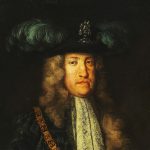 going to be the most shocking thing, but for me, I think the most shocking thing was the way that some of these kings died. It showed me that the times that these kings lived in were not only dangerous in that many of the health issues that are curable now, weren’t back then. But more shocking for me was that fact that kings were sometimes no more safe than anyone else. To accidently eat poison mushrooms would be a horrible death, and I can’t imagine going through that, but to be executed by guillotine is one of the most gruesome things I can think of, and that was not totally uncommon back then.
going to be the most shocking thing, but for me, I think the most shocking thing was the way that some of these kings died. It showed me that the times that these kings lived in were not only dangerous in that many of the health issues that are curable now, weren’t back then. But more shocking for me was that fact that kings were sometimes no more safe than anyone else. To accidently eat poison mushrooms would be a horrible death, and I can’t imagine going through that, but to be executed by guillotine is one of the most gruesome things I can think of, and that was not totally uncommon back then.
 For a number of years, I was out of touch with my cousin Dennis Fredrick, but all that changed a couple of years ago, when we started emailing. That has turned into a true friendship and I think it has been a blessing to both of us. Of course, our love of family history has given us common interests to explore, but there was so much more, because as cousins, we had a lot of memories to share too. I feel very blessed to have my cousin back in my life again. We are currently working together of different aspects of our research…or at least sharing our finds, because that is really what is so exciting about finding new family history information.
For a number of years, I was out of touch with my cousin Dennis Fredrick, but all that changed a couple of years ago, when we started emailing. That has turned into a true friendship and I think it has been a blessing to both of us. Of course, our love of family history has given us common interests to explore, but there was so much more, because as cousins, we had a lot of memories to share too. I feel very blessed to have my cousin back in my life again. We are currently working together of different aspects of our research…or at least sharing our finds, because that is really what is so exciting about finding new family history information.
One of the things that I found out recently about Denny was that, like his dad, his grandpa, his brother, and nephews, Denny builds furniture sometimes. And he does a very fine job of it. Not everyone has the ability to build furniture, and if we attempt, it often looks like a box slapped together. Not so, with Denny. I think his work looks like it was made in a factory…perfect. The dresser is for his daughter-in-law, Carrie Fredrick, who is feeling very blessed right now. Denny comes by is skill from a long like of furniture builders. Our grandpa, Allen Luther Spencer built furniture, as did Denny’s dad, Fritz Fredrick, who built the baptismal font for the little church in Holyoke, Minnesota. Denny’s brother, Gene Fredrick, who sadly passed away a number of years ago, also built beautiful furniture, as did Gene’s sons Tim and Shawn.
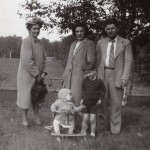
Denny, as we have called him all my life anyway, has a heart of gold, and really wants to be a part of the lives of his family, even those of us who live far away. It’s so easy to lose touch with friends and family, and while we often don’t feel the loss until we reconnect, sadly sometimes that never happens, and when a loved one is gone, we really fell that missed time. For that reason, I am so glad that Denny and I have reconnected while we are both still alive, and young enough to remember and enjoy the connection. I just wish I had more time to stay in touch, because since Denny retired, he is able to focus on the things he loves to do, which would be lovely. Today is Denny’s birthday. Happy birthday Denny!! Have a great day!! We love you!!

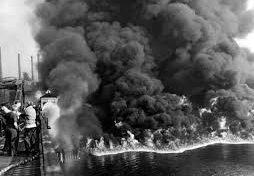 On October 20, 1944, in the city of Cleveland, Ohio, workers at the East Ohio Gas Company spotted a white vapor leaking from the large natural gas tank at the company plant near Lake Erie. It was 2:30 pm on that Friday afternoon, and a leak is never a good thing, but this one would prove to be disastrous. The circular tank had a diameter of 57 feet and could hold 90 million cubic feet of the highly flammable gas. Ten minutes later, a massive and violent explosion rocked the entire area. Flames went as high as 2,500 feet in the air. Everything in a half-mile vicinity of the explosion was completely destroyed. In the ensuing explosion, a smaller tank also exploded. The out-of-control fire that followed the explosion necessitated the evacuation of 10,000 people from the surrounding area.
On October 20, 1944, in the city of Cleveland, Ohio, workers at the East Ohio Gas Company spotted a white vapor leaking from the large natural gas tank at the company plant near Lake Erie. It was 2:30 pm on that Friday afternoon, and a leak is never a good thing, but this one would prove to be disastrous. The circular tank had a diameter of 57 feet and could hold 90 million cubic feet of the highly flammable gas. Ten minutes later, a massive and violent explosion rocked the entire area. Flames went as high as 2,500 feet in the air. Everything in a half-mile vicinity of the explosion was completely destroyed. In the ensuing explosion, a smaller tank also exploded. The out-of-control fire that followed the explosion necessitated the evacuation of 10,000 people from the surrounding area.
Originally built in 1902, the East Ohio Gas Company plant, spanned from East 55th to East 63rd Streets taking up a full ten acres. It provided natural gas to most of Cleveland, including many businesses in the neighborhood in which it was located. By 1940, part of the plant was converted to a liquefaction, storage, and regasification facility, which was one of the most modern gas plants in the country, safely storing large quantities of liquefied gas in four separate holding tanks. These days, we would not have these types of volatile substances stored in a residential area, but back then, before transportation became much more affordable, laborers in those early industrial cities had to be close to their places of employment. A gas storage facility was just one among many industrial operations that were located in a typical working-class neighborhood of that era. However, because the plant was modernized and had many safety features, people living in the area felt they had no reason to fear. That is, until a fateful day in October when “fire fell from the sky.”
The call went out to every firefighting unit in the Cleveland area. It took all of the city’s firefighters to bring the horrific industrial fire under control. In the end, the fire killed 130 people, destroyed two entire factories, 79 homes in the surrounding area and more than 200 vehicles. The total bill for damages exceeded $10 million. When the fire was out, rescue workers found that of the 130 people, killed by the blast, nearly half of the bodies were so badly burned that they could not be identified and in fact, 21 of them were never identified. Two hundred and fifteen people were injured and required hospitalization. The cause of the explosion had to do with the contraction of the metal tanks. The gas was stored at temperatures below negative 250 degrees and 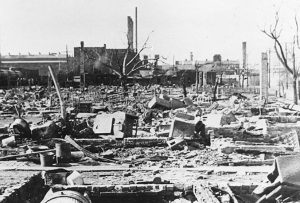
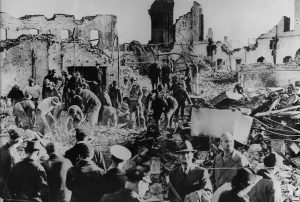 the resulting contraction of the metal had caused a steel plate to rupture. The East Ohio Gas Explosion has since been calculated to be equal to a 2.43 kiloton TNT explosion or 1/6 of the Hiroshima Atomic Bomb. In the aftermath of the fire, everyone knew that changes had to be made to protect laborers, and the people in the neighborhoods. Newer and far safer techniques for storing gas and building tanks were developed in the wake of this disaster.
the resulting contraction of the metal had caused a steel plate to rupture. The East Ohio Gas Explosion has since been calculated to be equal to a 2.43 kiloton TNT explosion or 1/6 of the Hiroshima Atomic Bomb. In the aftermath of the fire, everyone knew that changes had to be made to protect laborers, and the people in the neighborhoods. Newer and far safer techniques for storing gas and building tanks were developed in the wake of this disaster.

